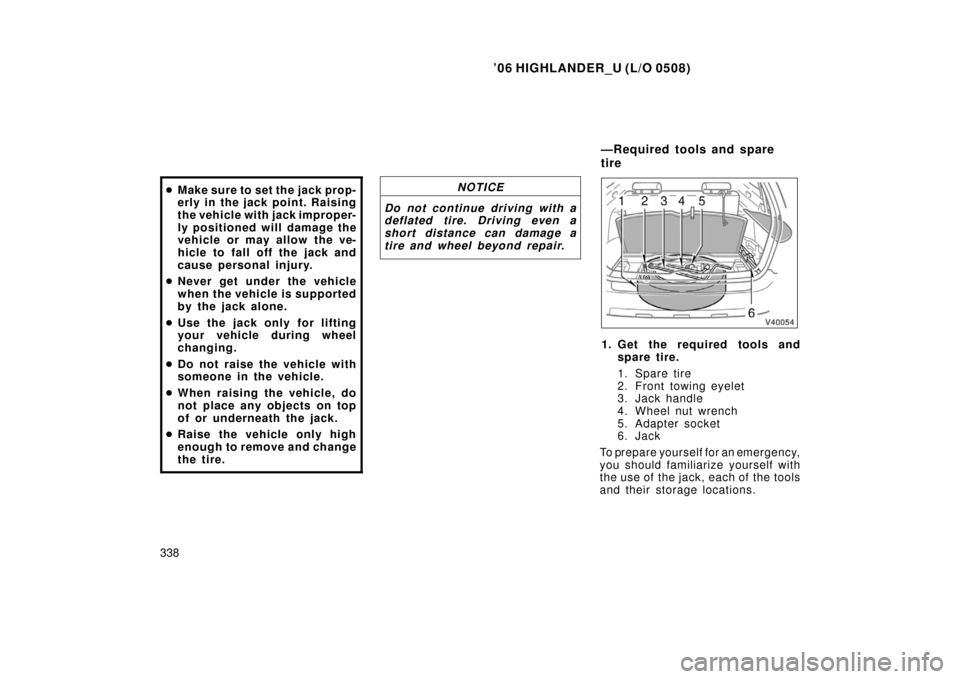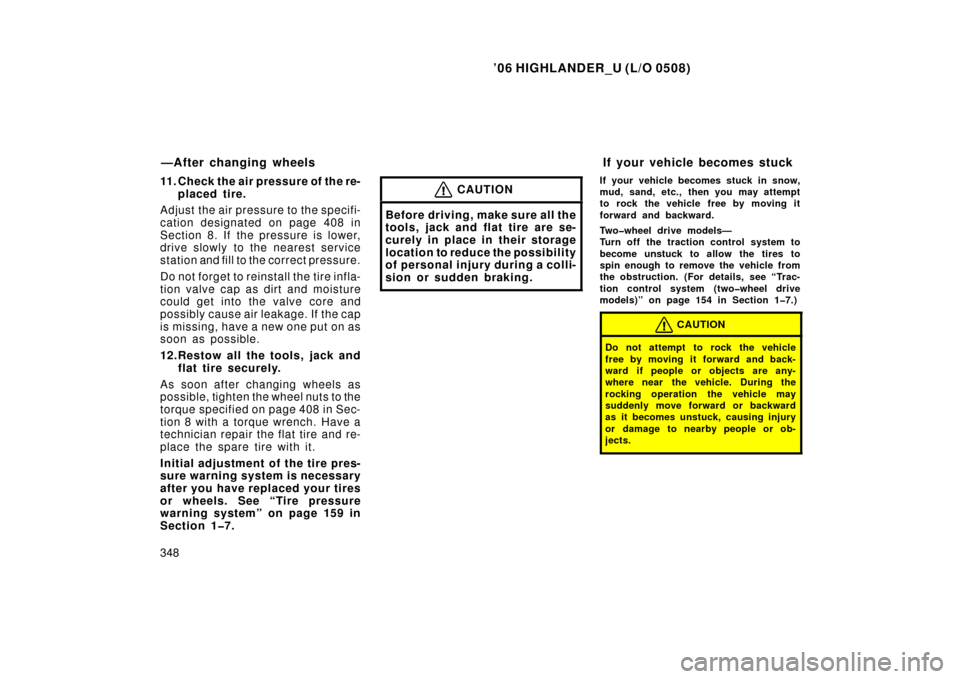Page 348 of 428

’06 HIGHLANDER_U (L/O 0508)
338�
Make sure to set the jack prop-
erly in the jack point. Raising
the vehicle with jack improper-
ly positioned will damage the
vehicle or may allow the ve-
hicle to fall off the jack and
cause personal injury.
� Never get under the vehicle
when the vehicle is supported
by the jack alone.
� Use the jack only for lifting
your vehicle during wheel
changing.
� Do not raise the vehicle with
someone in the vehicle.
� When raising the vehicle, do
not place any objects on top
of or underneath the jack.
� Raise the vehicle only high
enough to remove and change
the tire.
NOTICE
Do not continue driving with a
deflated tire. Driving even a
short distance can damage a
tire and wheel beyond repair.
1. Get the required tools and
spare tire.
1. Spare tire
2. Front towing eyelet
3. Jack handle
4. Wheel nut wrench
5. Adapter socket
6. Jack
To prepare yourself for an emergency,
you should familiarize yourself with
the use of the jack, each of the tools
and their storage locations.
— R eq u ired to o ls an d sp are
tire
Page 350 of 428
’06 HIGHLANDER_U (L/O 0508)
340
To detach the spare tire:
1. Vehicles with aluminium wheels— Remove the inside spare tire cov-
er by turning it counterclockwise.2. Pull the strap and open the centerdeck board.3. Vehicles with third seat—
If the third seat is upright, hang
the center deck board on the
right −side head restraint.
Page 352 of 428
’06 HIGHLANDER_U (L/O 0508)
342
7. Pull out the spare tire and stand
it up against the bumper.8. Remove the holding bracket.
Vehicles with aluminium wheels—
Remove the spare tire cover.2. Block the wheel diagonally op-posite the flat tire to keep the
vehicle from rolling when it is
jacked up.
When blocking the wheel, place a
wheel block in front of one of the front
wheels or behind one of the rear
wheels.
—Blocking the wheel
Page 354 of 428
’06 HIGHLANDER_U (L/O 0508)
344
CAUTION
Never use oil or grease on the
bolts or nuts. The nuts may loose
and the wheels may fall off,
which could cause a serious ac-
cident.
5. Position the jack at the correct
jack point as shown.
Make sure the jack is positioned on
a level and solid place.6. After making sure that no one is in the vehicle, raise it high
enough so that the spare tire
can be installed.
Remember you will need more ground
clearance when putting on the spare
tire than when removing the flat tire.
To raise the vehicl e, insert the jack
handle into the jack (it is a loose fit)
and turn it clockwise. As the jack
touches the vehicle and begins to lift,
double −check that it is properly posi-
tioned.
—Positioning the jack —Raising your vehicle
Page 355 of 428
’06 HIGHLANDER_U (L/O 0508)
345
CAUTION
Never get under the vehicle when
the vehicle is supported by the
jack alone.
7. Remove the wheel nuts and
change tires.
Lift the flat tire straight off and put it
aside.
Roll the spare wheel into position and
align the holes in the wheel with the
bolts. Then lift up the wheel and get
at least the top bolt started through
its hole. Wiggle the tire and press it
back over the other bolts.Before putting on wheels, remove any
corrosion on the mounting surfaces
with a wire brush or such. Installation
of wheels without good metal− to−met-
al contact at the mounting surface can
cause wheel nuts to loosen and
eventually cause a wheel to come off
while driving.
—Changing wheels
Page 358 of 428

’06 HIGHLANDER_U (L/O 0508)
348 11. Check the air pressure of the re-
placed tire.
Adjust the air pressu re to the specifi-
cation designated on page 408 in
Section 8. If the pressure is lower,
drive slowly to the nearest service
station and fill to the correct pressure.
Do not forget to reinstall the tire infla-
tion valve cap as dirt and moisture
could get into th e valve core and
possibly cause air leakage. If the cap
is missing, have a new one put on as
soon as possible.
12.Restow all the tools, jack and flat tire securely.
As soon after changing wheels as
possible, tighten the wheel nuts to the
torque specified on page 408 in Sec-
tion 8 with a torque wrench. Have a
technician repair the flat tire and re-
place the spare tire with it.
Initial adjustment of the tire pres-
sure warning system is necessary
after you have replaced your tires
or wheels. See “Tire pressure
warning system” on page 159 in
Section 1�7.
CAUTION
Before driving, make sure all the
tools, jack and flat tire are se-
curely in place in their storage
location to reduce the possibility
of personal injury during a colli-
sion or sudden braking.
If your vehicle becomes stuck in snow,
mud, sand, etc., then you may attempt
to rock the vehicle free by moving it
forward and backward.
Two�wheel drive models—
Turn off the traction control system to
become unstuck to allow the tires to
spin enough to remove the vehicle from
the obstruction. (For details, see “Trac-
tion control system (two�wheel drive
models)” on page 154 in Section 1�7.)
CAUTION
Do not attempt to rock the vehicle
free by moving it forward and back-
ward if people or objects are any-
where near the vehicle. During the
rocking operation the vehicle may
suddenly move forward or backward
as it becomes unstuck, causing injury
or damage to nearby people or ob-
jects.
—After changing wheels If your vehicle becomes stuck
Page 398 of 428

’06 HIGHLANDER_U (L/O 0508)
388 The tires on your Toyota have built −in
tread wear indicators to help you
know when the tires need replace-
ment. When the tread depth wears to
1.6 mm (0.06 in.) or less, the indica-
tors will appear. If you can see the
indicators in two or more adjacent
grooves, the tire should be replaced.
The lower the tread, the higher the
risk of skidding.
The effectiveness of snow tires is
lost if the tread wears down below
4 mm (0.16 in.).
If you have tire damage such as
cuts, splits, cracks deep e nough to
expose the fabric, or bulges indi-
cating internal damage, the tire
should be repl aced.
If a tire often goes flat or cannot be
properly repaired due to the size or
location of a cut or other damage, it
should be replaced. If you are not
sure, consult with your Toyota dealer. If air loss occurs while driving, do not
continue driving. Driving even a short
distance can damage a tire beyond
repair.
An y ti res wh i ch are over 6 years
old must be checked by a qualified
technician even if damage is not
obvious.
Tires deteriorate with age even if they
have never or seldom been used.
This applies also to the spare tire and
tires stored for future use.
REPLACING YOUR TIRES
When replacing a tire, use a tire of
the same size and construction,
and the same or greater maximum
load as the originally installed
tires. Also, on four�wheel drive
models, all the tires must be the
same brand and have the same
tread patterns.
Using any other size or type of tire
may seriously affect handling, ride,
speedometer/odometer calibration,
ground clearance, and clearance be-
tween the body and tires or snow
chains.
Check that the maximum load of the
replaced tire is greater than 1/2 of the
Gross Axle Weight Ratings (GAWR)
of either the front axle or the rear
axle, whichever is greater. As for the
maximum load of the tire, see the load
limit at maximum cold tire inflation
pressure mentioned on the sidewall
of the tire, and as for the Gross Axle
Weight Ratings (GAWR), see the Cer-
tification Label.
Page 418 of 428

’06 HIGHLANDER_U (L/O 0508)
408 Tire size and cold tire inflation pressure:
kPa (kgf/cm
2 or bar, psi)
Ti r e siz e
Ti r e inf lat ion pr es s ur eWheel sizeFrontRearSpare
P225/70R16 101S210 (2.1, 30)210 (2.1, 30)210 (2.1, 30)16 �6 1/ 2 JJ
225/65R17 101S210 (2.1, 30)210 (2.1, 30)210 (2.1, 30)17 �6 1/ 2 JJ
When driving under the above load condition at sustained high speeds above 160 km/h (100 mph), in countries where
such speeds are permitted by −low, inflate the front and rear tires to the following tire inflation pressure provided that
it does not exceed the maximum cold tire in flation pressure molded on the tire sidewall.
P225/70R16 101S tires 240 kPa (2.4 kgf/cm
2 or bar, 35 psi)
225/65R17 101S tires 230 kPa (2.3 kgf/cm2 or bar, 33 psi)
Wheel nut torque, N
·m (kgf·m, ft·lbf):
103 (10.5, 76)
NOTE: For a complete information on tires (e.g. replacing ti res or replacing wheels), see “Checking tire inflation pres-
sure” through “Aluminum wheel precautions”, pages 385 through 392, in Section 7 −2.
Tires